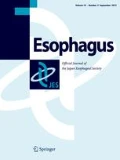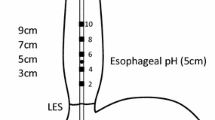Abstract
Background and aim
The clinical significance of minimal changes in non-erosive reflux disease (NERD) is controversial. Multichannel intraluminal impedance–pH (MII-pH) monitoring enables classification of NERD. The aim of this study was to evaluate associations between endoscopic findings and functional assessment via MII-pH monitoring in patients with proton-pump inhibitor (PPI)-refractory NERD.
Methods
Thirty-four PPI-refractory NERD patients were retrospectively analyzed. On the basis of the MII-pH monitoring results, cases were classified as acid reflux, non-acid reflux, and functional heartburn. Minimal changes such as white turbidity, erythema, loss of fine vascular network pattern at the esophagogastric junction, hyperplasia of vascular network at the middle esophagus, hernia, flap valve grade, and atrophic gastritis were evaluated endoscopically.
Results
Among 34 patients, 8 were categorized with acid reflux, 17 with non-acid reflux, and 9 with functional heartburn. There were no differences in the prevalence of minimal changes among the groups, but all cases showing white turbidity of the entire esophageal circumference involved non-acid reflux. The prevalence of hiatal hernia and abnormal flap valve did not differ among the three groups, but the presence of atrophic gastritis was significantly more common in patients with functional heartburn than in those with acid and non-acid reflux. The prevalence of hyperplasia of the vascular network at the middle esophagus was significantly higher in patients with proximal migration than in those without.
Conclusion
There are associations between endoscopic findings and functional assessment via MII-pH monitoring. Future studies should pay more attention to the endoscopic findings at the middle esophagus.





Similar content being viewed by others
References
Fujiwara Y, Arakawa T. Epidemiology and clinical characteristics of GERD in the Japanese population. J Gastroenterol. 2009;44:518–34.
Fass R, Shapiro M, Dekel R, Sewell J. Systematic review: proton-pump inhibitor failure in gastro-oesophageal reflux disease—where next? Aliment Pharmacol Ther. 2005;22:79–94.
Dean BB, Gano AD Jr, Knight K, Ofman JJ, Fass R. Effectiveness of proton pump inhibitors in nonerosive reflux disease. Clin Gastroenterol Hepatol. 2004;2:656–64.
Fass R. Proton pump inhibitor failure—what are the therapeutic options? Am J Gastroenterol. 2009;104(Suppl 2):S33–8.
Hongo M. Minimal changes in reflux esophagitis: red ones and white ones. J Gastroenterol. 2006;41:95–9.
Armstrong D, Bennett JR, Blum AL, Dent J, De Dombal FT, Galmiche JP, Lundell L, Margulies M, Richter JE, Spechler SJ, Tytgat GN, Wallin L. The endoscopic assessment of esophagitis: a progress report on observer agreement. Gastroenterology. 1996;111:85–92.
Hoshihara Y, Hashimoto M. Endoscopic classification of reflux esophagitis (in Japanese). Nippon Rinsho. 2000;58:1808–12 (in Japanese with English abstract).
Amano Y, Ishimura N, Furuta K, Okita K, Masaharu M, Azumi T, Ose T, Koshino K, Ishihara S, Adachi K, Kinoshita Y. Interobserver agreement on classifying endoscopic diagnoses of nonerosive esophagitis. Endoscopy. 2006;38:1032–5.
Miwa H, Yokoyama T, Hori K, Sakagami T, Oshima T, Tomita T, Fujiwara Y, Saita H, Itou T, Ogawa H, Nakamura Y, Kishi K, Murayama Y, Hayashi E, Kobayashi K, Tano N, Matsushita K, Kawamoto H, Sawada Y, Ohkawa A, Arai E, Nagao K, Hamamoto N, Sugiyasu Y, Sugimoto K, Hara H, Tanimura M, Honda Y, Isozaki K, Noda S, Kubota S, Himeno S. Interobserver agreement in endoscopic evaluation of reflux esophagitis using a modified Los Angeles classification incorporating grades N and M: a validation study in a cohort of Japanese endoscopists. Dis Esophagus. 2008;21:355–63.
Manabe N, Haruma K, Hoshihara Y, Kinoshita Y, Hongo M, Makuchi H. Interobserver agreement on endoscopic diagnosis of low-grade reflux esophagitis, including minimal changes. Esophagus. 2012;9:9–16.
Takubo K, Honma N, Aryal G, Sawabe M, Arai T, Tanaka Y, Mafune K, Iwakiri K. Is there a set of histologic changes that are invariably reflux associated? Arch Pathol Lab Med. 2005;129:159–63.
Sifrim D, Castell D, Dent J, Kahrilas PJ. Gastro-oesophageal reflux monitoring: review and consensus report on detection and definitions of acid, non-acid, and gas reflux. Gut. 2004;53:1024–31.
Zerbib F, Duriez A, Roman S, Capdepont M, Mion F. Determinants of gastro-oesophageal reflux perception in patients with persistent symptoms despite proton pump inhibitors. Gut. 2008;57:156–60.
Kohata Y, Fujiwara Y, Machida H, Okazaki H, Yamagami H, Tanigawa T, Watanabe K, Watanabe T, Tominaga K, Arakawa T. Pathogenesis of proton-pump inhibitor-refractory non-erosive reflux disease according to multichannel intraluminal impedance–pH monitoring. J Gastroenterol Hepatol. 2012;27(Suppl 3):58–62.
Kogure T, Akiyama H, Itai Y, Okayama Y, Kimura K, Dochi K. Diagnosis and clinical course of esophagitis—criteria for endoscopic diagnosis as compared with histological findings. Stomach and Intestine. 1972;7:1293–304 (in Japanese with English abstract).
Makuuchi H. Clinical study of sliding esophageal hernia—with special reference to the diagnostic criteria and classification of the severity of the disease. Nihon Shokakibyo Gakkai Zasshi. 1982;79:1557–67 (in Japanese with English abstract).
Hill LD, Kozarek RA, Kraemer SJ, Aye RW, Mercer CD, Low DE, Pope 2nd CE. The gastroesophageal flap valve: in vitro and in vivo observations. Gastrointest Endosc. 1996;44:541-7.
Kimura K, Takemoto T. An endoscopic recognition of the atrophic border and its siginificance in chronic gastritis. Endoscopy. 1969;3:87–97.
Ohara S, Kouzu T, Kawano T, Kusano M. Nationwide epidemiological survey regarding heartburn and reflux esophagitis in Japanese. Nihon Shokakibyo Gakkai Zasshi. 2005;102:1010–24 (in Japanese with English abstract).
Nakamura T, Shirakawa K, Masuyama H, Sugaya H, Hiraishi H, Terano A. Minimal change oesophagitis: a disease with characteristic differences to erosive oesophagitis. Aliment Pharmacol Ther. 2005;21(Suppl 2):19–26.
Lee JH, Kim N, Chung IK, Jo YJ, Seo GS, Kim SW, Im EH, Kim HR, Park SH, Lee SY, Cha HM, Lee KS, Hyun DH, Kim HY, Kim SM, Shin JE, Park SH, Chung HC, Chung IS. Clinical significance of minimal change lesions of the esophagus in a healthy Korean population: a nationwide multi-center prospective study. J Gastroenterol Hepatol. 2008;23:1153–7.
Kim JB, Shin SR, Shin WG, Choi MH, Jang HJ, Kim KO, Park CH, Baek IH, Baik GH, Kim KH, Park SH, Kae SH, Lee MS, Kim HY. Prevalence of minimal change lesions in patients with non-erosive reflux disease: a case–control study. Digestion. 2012;85:288–94.
Kiesslich R, Kanzler S, Vieth M, Moehler M, Neidig J, Thanka Nadar BJ, Schilling D, Burg J, Nafe B, Neurath MF, Galle PR. Minimal change esophagitis: prospective comparison of endoscopic and histological markers between patients with non-erosive reflux disease and normal controls using magnifying endoscopy. Dig Dis. 2004;22:221–7.
Kusano M, Shirai N, Yamaguchi K, Hongo M, Chiba T, Kinoshita Y. It is possible to classify non-erosive reflux disease (NERD) patients into endoscopically normal groups and minimal change groups by subjective symptoms and responsiveness to rabeprazole—a report from a study with Japanese patients. Dig Dis Sci. 2008;53:3082–94.
Kim JH, Park H, Lee YC. Is minimal change esophagitis really part of the spectrum of endoscopic findings of gastroesophageal reflux disease? A prospective, multicenter study. Endoscopy. 2011;43:190–5.
Jones R, Junghard O, Dent J, Vakil N, Halling K, Wernersson B, Lind T. Development of the GerdQ, a tool for the diagnosis and management of gastro-oesophageal reflux disease in primary care. Aliment Pharmacol Ther. 2009;30:1030–8.
Joh T, Miwa H, Higuchi K, Shimatani T, Manabe N, Adachi K, Wada T, Sasaki M, Fujiwara Y, Hongo M, Chiba T, Kinoshita Y. Validity of endoscopic classification of nonerosive reflux disease. J Gastroenterol. 2007;42:444–9.
Lei WY, Liu TT, Yi CH, Chen CL. Disease characteristics in non-erosive reflux disease with and without endoscopically minimal change esophagitis: are they different? Digestion. 2012;85:27–32.
Sifrim D, Zerbib F. Diagnosis and management of patients with reflux symptoms refractory to proton pump inhibitors. Gut. 2012;61:1340–54.
Kouzu T, Yamada H, Miyazaki S, Yoshimura K, Hishikawa E, Arima M, Harada N, Ichinose M, Ninomiya E, Isono K. A proposed classification of reflux esophagitis with special references to the endoscopic aspects. Stomach Intest. 1992;27:1003–8 (in Japanese with English abstract).
Yoshikawa I, Yamasaki M, Yamasaki T, Kume K, Otsuki M. Lugol chromoendoscopy as a diagnostic tool in so-called endoscopy-negative GERD. Gastrointest Endosc. 2005;62:698–703.
Sharma P, Wani S, Bansal A, Hall S, Puli S, Mathur S, Rastogi A. A feasibility trial of narrow band imaging endoscopy in patients with gastroesophageal reflux disease. Gastroenterology. 2007;133:454–64.
Banerjee R, Reddy DN. Minimal-change esophagitis on narrow-band imaging. Clin Gastroenterol Hepatol. 2008;6:A26.
Ethical Statement
All procedures followed were in accordance with the ethical standards of the responsible committee on human experimentation (institutional and national) and with the Helsinki Declaration of 1964 and later versions. Informed consent or substitute for it was obtained from all patients for being included in the study.
Conflict of interest
All authors, Y. Fujiwara, Y. Kohata, T. Tanigawa, H. Yamagami, M. Shiba, K. Tominaga, T. Watanabe, T. Arakawa, declare that they have no conflict of interest.
Author information
Authors and Affiliations
Corresponding author
Rights and permissions
About this article
Cite this article
Fujiwara, Y., Kohata, Y., Tanigawa, T. et al. Associations between endoscopic findings and functional assessment via multichannel intraluminal impedance–pH monitoring in patients with non-erosive reflux disease refractory to proton-pump inhibitors. Esophagus 12, 244–250 (2015). https://doi.org/10.1007/s10388-014-0480-2
Received:
Accepted:
Published:
Issue Date:
DOI: https://doi.org/10.1007/s10388-014-0480-2




